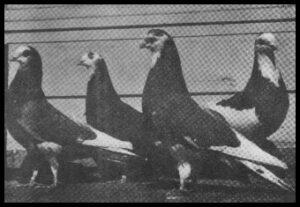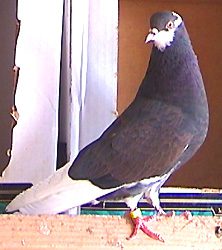
The Red Badge cock with the “Brooch” marking in the foreground is the famous “Fireball” cock, the namesake of the strain and was hatched in 1931.
This page is being inserted as a “place holder” until we have time to work up some of the current information.
There are a few dedicated breeders of this old line of Rollers still to be found and we hope to add some of their information.
Fireball Rollers
Alan Bliven has a section on his website about his Fireball Rollers.
|
The Fireball roller is a strain started by James Graham from the Whittingham strain of Roller My strain of Fireballs are from the Hank Johnson family. Mr. Johnson is now too old to keep Rollers and I have taken over his life's work. He has had this strain for more than 60 years. |
|
| Rev. Graham’s strain of the Whittingham family of Rollers were imported before Pensom’s birds came here in the 30’s. Mr. Whittingham was in England and McAree from Canada started importing Whittingham’s birds around the turn of the century. Graham was a student of McAree and started the Fireball strain from McAree’s Whittinghams.
Mr. Les Manz also worked with Whittinghams imported by Hargrove but crossed his into the Rollers of Karp. North American Highflying Rollers are an American created breed distinct from, but related to Birminghams. They started out in 1860’s when George Stevens of Toronto crossed an Almond Oriental Roller cock to an extreme roll down Birmingham Roller hen. The young of this pair were valued at the time because they were very high and long fliers and deep rollers and spread fast around the northeast. In the next 20 years much more cross breeding took place including about 7-8 different performing breeds, with the majority of the blood being made up of performing type Komorners and Orientals, with very little Birmingham blood left in them. After the Whittinghams came into the states after the turn of the century, almost all of the NAHFR’s got crossed into the Whittingham blood. The idea of the NAHFR is to have the endurance and height of a Tippler but roll extremely deep. American Rollers arose in the 40’s and 50’s by re crossing the NAHFR’s back into Birminghams. The idea here is to have a breed in-between the NAHFR and the Birmingham… a deep roller but one that doesn’t fly so high and so long. There are some Whittingham’s that didn’t go through Graham’s lofts and there are some of Graham’s Fireballs that others crossed into other types of Rollers through the years. And most of the Whittinghams and NAHFR’s were also cross bred. The NAHFR’s gave the Whittingham’s more depth and the Whittinghams helped the roll of the NAHFR’s. So, as you can see there’s been a lot of cross breeding with these birds prior to the 1950’s. |
|
|
The following is taken from Rev Graham’s own words on the beginning of the Fireball Roller. The original “Fireball” was a Red badge cock bird that the Rev Graham bred in 1932 from some Whittingham strain birds he bought from J. V. McAree of Toronto CA. Graham said of McAree, “many of the old timers regarded McAree as the most outstanding Roller breeder on this continent” at the time. Graham said Fireball was of sticking appearance, with jet black eyes like a mouse. He was a fine performer and established himself as the favorite in his loft. The following year, 1934, he moved to far Northern Ontario, where he counted on Fireball to start a new dynasty of Rollers for him. But the day after he arrived there in mid-January, he shot out the door of the shed where he had stored them temporarily, took several rolls by way of fare-well, and he never saw him again. That night the temperature plummeted to a record 64 degrees below zero and there Fireball died. Fortunately, he kept one of Fireball’s sons and looked to this young bird instead of the father. He mated him to a succession of selected hens. In later years, he took direct descents of his and paired them to all other birds in his breeding pen. In that fashion he could truly claim that every bird he raised had some trace of Fireball’s blood in it, although by that time of course it was minimal. By 1940, his strain of birds (Fireballs) had become so wide-spread on this side of the Pond that they started the FIREBALL CLUB. Two of the charter members of the club were Sam Saunders of Maine and CA Nordland of Portland Oregon. At the close of WW2, Graham moved back to Toronto and shared McAree’s large loft. With all the talk about Bill Pensom, McAree had Mr. Pensom send him three pairs that were the best in England. But after a couple of years of thorough trial, Graham and McAree found that those birds added nothing at all to their own stock, and from that time on they both kept exclusively Whittingham’s which they found unsurpassed in every way. When old age compelled McAree to retire from the fancy in 1953, Graham took all his Rollers amounting to 300 Rollers in their combined flock.
This is a photo of four of Graham’s best Whittingham’s while “Fireball” was still alive. |
|
|
“Whittingham” By J.V. McAree (1948) Twenty-five years ago, thirty five years ago and fifty years ago, the name of Whittingham was the best known in the world among Roller breeders. He sent birds from Wolverhampton, a suburb of Birmingham, as it might be called, to South Africa, to Australia, the United States, Canada, and wherever else Birmingham Rollers were bred. From about 1905 or 1906, I began importing from Whittingham generally a half dozen pairs a year and never a bad one. Then, in 1910, I was in England and saw a man well past 70 I should think. He had a small, low brick loft in the rear of his house and there were two or three pairs of birds in it. He told me then that the birds I had been buying for several years past had actually been bred by his son, William Whittingham, who lived in Worcester, but that he had been responsible for their description, having seen them fly. Two or three years later, Thomas Whittingham died, and with an interval of four or five years, when I was out of pigeons, I got birds from William Whittingham. Then he died and another Thomas, his son, sold me pigeons for several years. I could see no difference in spinning quality. Eight years ago, I imported some Roller Canaries from Thomas Whittingham, for he was quite a noted exhibitor of them, and I have not heard from him since. In the course of the war, I gave several young Canadian soldiers his address in Worcester, but I have not heard that any of them ever saw him. He must have been one of the greatest Roller |
From long time keeper of Fireballs, Jack Chambers, we learn the following.
Fireball Rollers
I am currently maintaining a small family of the famous Fireball Rollers. During the 1930’s and early 1940’s, the Fireballs were considered one of the most important strains of North American Highflying Roller Pigeons and gave the Pensom imports their biggest run for their money in Roller supremacy.

 that was introduced in America around 1900. The Fireballs were and are long and high flying, very deep rollers.
that was introduced in America around 1900. The Fireballs were and are long and high flying, very deep rollers.